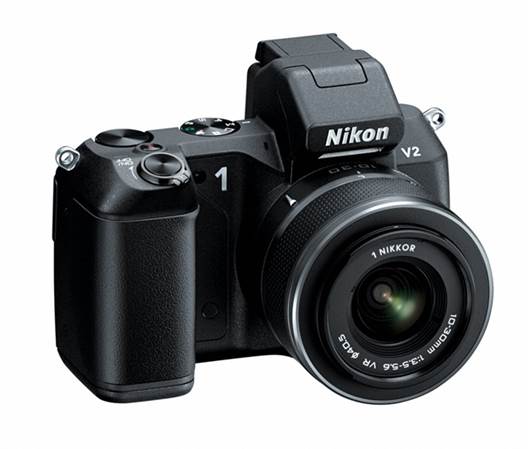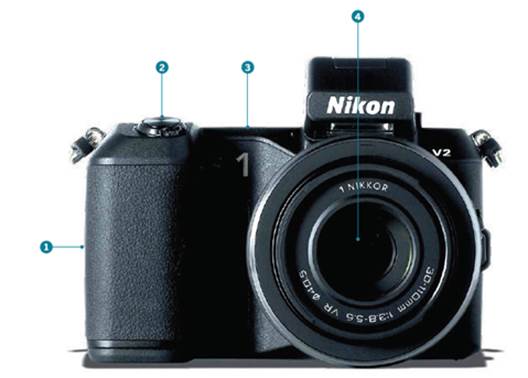Nikon 1 V2
A smaller sensor and bigger body is a bad
combination for Nikon Pitched at enthusiasts, Nikon’s second-gen V2 succeeds
2011’s V1 with a more serious, angular design. The new look is chiefly due to a
new top plate housing an integral flash, plus an EVF. The aluminum and mag
alloy body includes a handgrip, although this makes it a squeeze for most
pockets.

Nikon
1 V2
Its 14.2-megapixel, CX-format CMOS chip is
bigger than your standard compact cam but smaller than the ones gracing Canon,
Fujifilm and Sony’s cams, and as a result image quality falls behind rivals.
At their worst the V2’s shots aren’t too
dissimilar to the results you’d see from a point-and-shoot job, with familiar
issues such as pixel fringing and softness to shots even when the built-in flash
is deployed indoors. There’s also some sharpness lost toward the corner of the
frame at maximum zoom. Full-HD video fares better, shooting at a cinematic
60fps with proper stereo sound.
Images are composed using either the
eye-sensor-activated electronic viewfinder or the three-inch LCD. You can use
the latter to frame shots and utilize Nikon’s Live Image control to display the
effects of making ISO or filter adjustments in real time.
All of the controls are clearly laid out
and unlikely to fox newcomers. You also get a decent 310-shot battery life.
The 10-30mm bundled kit lens is a bit
basic. One could opt for the double kit lens, which adds a more respectable,
30-110mm telephoto. Like Canon, Nikon has few dedicated CSC lenses but a huge
range of 60 DSLR lenses, which you can make use of with the Nikon FT1 adaptor.
Though the V2 looks good and handles well, you’ll get much better photographic
results elsewhere.

The
10-30mm bundled kit lens is a bit basic. One could opt for the double kit lens,
which adds a more respectable, 30-110mm telephoto
Details
1. Screen: Live View on the LCD shows how settings changes affect your
shots
2. Controls: Mode dial on top, DSLR-like command wheel at rear
3. Video: You get one-touch, full-HD video recording at 60fps with
stereo sound
4. Kit lens: Basic 10-30mm zoom, plus a 30-110mm if you opt for the
dual kit lens

Nikon
1 V2 details
Accessorize: Nikon 1 lenses
Nikon has announced three new lenses for
its ‘1’ system: an ultra-wide angle, a 32mm telephoto and 10x optical zoom, taking
its total to five. Invest in the FT1 adaptor ($211) and you can also use all 60
of Nikon’s NIKKO R lenses.
The verdict
Love: Can be used with Nikon’s lenses, via
FT1 adaptor. Built-in flash and viewfinder
Hate: Smaller sensor than other cams on
test. Image quality not much better than a compact
T3 Says: Nikon’s V2 looks the part, but
image quality falls well below expectations
T3: 3/5
Nikon 1 V2 Specifications
·
Sensor: 14.2-megapixel, 13.2x8.8mm CX CMOS
·
Video: 1920x1080 at 30fps or 60fps with stereo
sound
·
Lens: 10-30mm (plus 30-110mm zoom with double
lens kit)
·
Lens mount: Nikon 1 screen 3-inch, 921k-dot LCD
·
Formats: JPEG, RAW ISO range 160-6,400
·
Battery life: 310 shots
·
Dimensions: Height: 82mm; Width: 108mm;
Depth: 46mm; Weight: 338g
Olympus E-PL5: $794
A good all-round compact system cam and a
solid

Olympus
E-PL5
Olympus upgrade Pitched as an affordable
alternative to Olympus’s flagship $1,183+ OM-D E-M5, the E-PL5 includes the
same 16.3-megapixel, CMOS sensor, TruePic VI processor and Micro Four Thirds
mount for a much lower price. The OM-D’s five-axis in-body ant shake is absent,
but you get dual-axis stabilization – a novelty amongst compact system cams
which usually rely upon image stabilized lenses.
Photos are impressive; with colors sporting
attractive warmth that means little, if any, post production work is required.
Eschew manual settings for point-and-shoot ease and you’ll still get great
results which deliver more than enough detail.
The E-PL5 benefits from lightning-fast,
0.01-second autofocus. The bundled zoom is also quick to re-focus when shooting
video, even if you rapidly swap between subjects mid-shooting. It’s also
remarkably quiet, never making itself heard on film.
There’s no built-in flash, but a small
clip-on variety is available for $62. It is powerful and delivers a reasonably
clean output without washing out the subject.

The
E-PL5 is a great alternative to a DSLR, with a price-tag that won’t put off
newcomers.
What we did not appreciate were the small,
fiddly rear plate controls. Instead, using the tilt able, three-inch LCD
touchscreen is a much better option and, thankfully, doesn’t drain the battery
too quickly either – you still get 360 shots from a full charge. Though, beware
of the overly colorful touchscreen, which tends to make captures look very warm
indeed.
Olympus was one of the first manufacturers
to produce a compact system cam and its experience is certainly paying off. The
E-PL5 is a great alternative to a DSLR, with a price-tag that won’t put off
newcomers.
Details
1. Screen: Three-inch touchscreen makes operation simple
2. Controls: Backplate buttons are unnecessarily small, but touchscreen
and top dials add to usability
3. Video: Full-HD video at 30fps with quick autofocus
4. Kit lens: A 14-42mm, F3.5-5.6 lens is standard

Olympus
E-PL5 details
Accessorize: Olympus Micro Four Thirds
and MFT lenses
There are 20+ directly compatible lenses in
existence. The weather-sealed MMF-3 Four Thirds adaptor ($182) ups the count
even more.
The verdict
Love: Anti-shake built into the camera
body. Speedy autofocus for stills and video. Good battery life
Hate: Fiddly button controls. No built-in
flash
T3 Says: A great entry-level compact system
cam
Rating: 4/5
Olympus E-PL5 Specifications
·
Sensor: 16.3-megapixel Four Thirds CMOS sensor
·
Video: 1920x1080 at 30fps
·
Lens: 14-42mm zoom
·
Lens Mount: Micro Four Thirds screen Three-inch,
460k-dot touchscreen
·
Format: JPEG, RAW, JPEG+RAW
·
ISO range: 200-25,600
·
Battery life: 360 shots
·
Dimensions: Height: 64mm; Width: 110mm;
Depth: 38mm; Weight: 325g